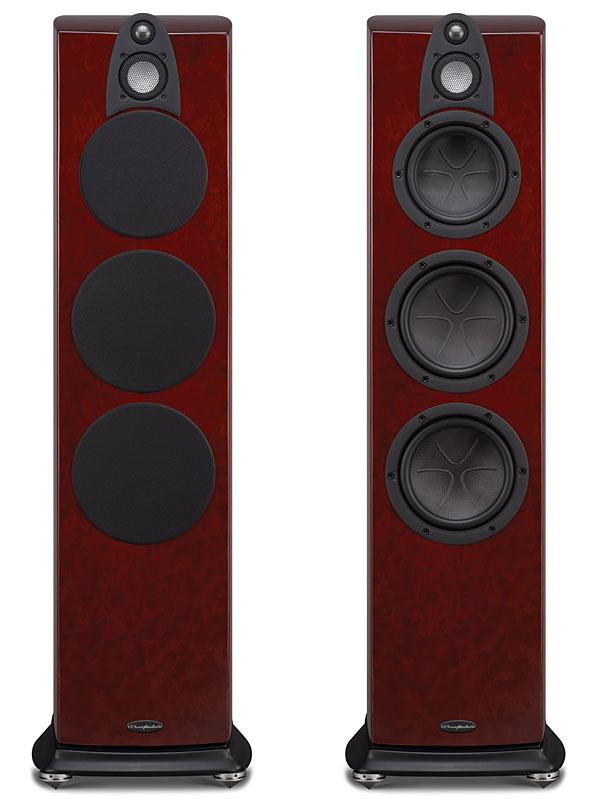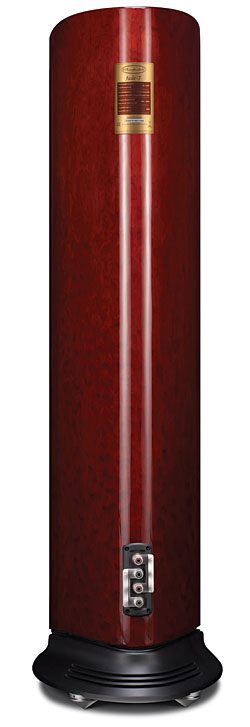| Columns Retired Columns & Blogs |
My guess would be they produce better loudspeakers because they had much better LP's for many years.

Founded in 1932 by Gilbert Briggs, Wharfedale is the second-oldest-established of the companies listed. Tannoy, founded in 1926 as the Tulsamere Manufacturing Company, can lay claim to being the first. And while Tannoy may have additional bragging rights for "the Tannoy" being a generic term in Britain for loudspeakers in a PA system, Wharfedale can argue that they literally wrote the book on loudspeakers: Loudspeakers: The Why and How of Good Reproduction, by Gilbert Briggs, published in 1948, with several follow-ups through the years (footnote 1).
Like many other audio manufacturers, Wharfedale has gone through changes of ownership through the years, and is now part of the International Audio Group (IAG), which includes Quad, Mission, Audiolab, and Castle. The acoustic design of the Jade series is headed by well-known speaker designer Peter Comeau (ex-Mission, ex-Heybrook, ex-NXT); the speakers are manufactured in China.
At the technical level, Wharfedale has made a number of innovations, the best known being speaker-cabinet walls filled with sand, and what Briggs called "aperiodic loading" of the cabinet and speaker. This is a kind of compromise between an open port and a sealed box, the air flow through the port being partially blocked, and thus having much of the efficiency advantage of the former and the improved transient characteristic of the latter.
 Description and Design
Description and Design
The 7 is the largest speaker of the Jade line, which includes two stand-mounted and two floorstanding designs, as well as models designed specifically for home theaters. It's a substantial-looking speaker, and its 82-lb weight means that it's solidly built. The front of the Jade 7 is curved, as are the side, converging at the back. Five finishes are available; the review samples were in Rosewood, which I thought looked a bit dull (my preference is for Piano Black), but when I asked my wife what she thought of the finish, the word she used was gorgeous—so I guess there's room for diversity of opinion here. The Jade 7 comes with individual round covers for its midbass and bass drive-units. These are not shown in the product brochure, and I think I know why: they give the speaker a dated appearance, and while they may provide some protection from people who like to poke speaker drivers with their fingers, I can't see the covers having any sonic benefit. I left them off for my auditioning. The midrange cone and the tweeter have permanent metal grilles.
The drivers are designed and manufactured specifically for the Jade series. The cones are made of a proprietary material called Acufibre, which combines glass and carbon fiber in a self-damping woven matrix, and have a molded pattern designed to break up standing waves. The voice-coil features shorting rings to reduce inductance. The crossover networks are phase linear, and have been developed using measurements, computer modeling, and extensive listening tests.
The Jade 7's cabinet is made of a new, proprietary, laminated substance called Crystalam, composed of natural wood elements and composites and designed to reduce panel vibrations and distribute resonances over a wider range. The Jade 7 uses a modern version of the aperiodic loading developed by Wharfedale founder Gilbert Briggs. Here, this consists of a space between the cabinet and the plinth that is filled with resistive porous foam that controls the air flow.
Break-in
One of the things that I've learned about reviewing audio equipment over the years is to avoid making snap judgments, especially with speakers. The sound you hear from a speaker when you first hook it up may not come close to representing that speaker's potential. Sometimes, slight differences in setup parameters (distance between speakers, toe-in, vertical angle, distances from the front and side walls) can make a considerable sonic difference. You may have the speakers set up in a way that you think is pretty close to optimal; then you move them a little closer together or farther apart, and suddenly the soundstage is more precisely focused—or more vague, in which case you restore the original inter-speaker distance.
Even if you have the perfect physical setup—a perfection that, arguably, can only be approached, never attained—there may be changes in the sound of the speaker over time that constitute the break-in phenomenon. Almost all speaker manufacturers acknowledge that this phenomenon exists, but not all warn the consumer about it. It's important for a reviewer to base his or her conclusions on the way the speaker sounds after the break-in period, but how do you know when that period is over? You might think that manufacturers would put review samples through a break-in regimen at the factory, but, in my experience, they seldom do. Most of the time, the speakers the reviewer gets are from regular stock, with no prior break-in, and perhaps that's as it should be—that way, the reviewer is treated the same as the consumer.
In the case of the Jade 7, Walter Schofield, VP of Sales and Marketing of Wharfedale USA, told me that the review samples had gotten no special break-in, but warned me that "the Jade 7s do like an extended break-in time." He suggested 120–150 hours, playing a wide range of music.
My initial impressions, once I was satisfied that the speaker positions were about right, but before any break-in as such, were certainly positive: the sound was wide-ranging, with no obvious colorations or overemphasis of any part of the audioband, but dynamically on the "polite" side, somewhat lacking in transparency, and with the highs a bit muted.
So I proceeded to put the speakers through the break-in recommended by Schofield. I played mostly orchestral music, at levels that were on the high side for me, as well as the break-in tracks of Nordost's System Set-Up & Tuning Disc (CD, Nordost CD NOR 101) and Monitor Audio's System De-Tox (CD, Monitor Audio). A couple of weeks after the speakers' arrival, my wife and I went away for a weekend, and I left the system playing Reference Recordings' Tutti! sampler (RR-906CD) at a fairly high level. That took care of some 60 hours of the recommended break-in period. And sure enough, on our return, the sound had changed in a very significant and positive direction. Were the speakers now well and truly broken in? The improvement was such that it was tempting to conclude so, but this was still far short of the recommended 120–150 hours; I kept my judgments in abeyance and continued to listen to music casually, leaving the system playing at a higher level when we were out of the house.
Every once in a while I played some of my usual reference recordings, listening for any changes from what I'd heard before, and continued to go through the listen/break-in/listen routine until I felt that the sound of the speakers had truly settled down—which was close to the 150 hours of playing that Schofield had recommended. Compared to the pre–break-in sound of the speakers—with no changes in speaker positions, and no changes in the rest of the system (which was well past any possible break-in period)—the sound of the Jade 7s was now more open and more detailed, with crisper transients and subjectively more extended highs; in general, music sounded more lively and involving.
Amplifiers
I used two power amplifiers with the Jade 7: the Simaudio Moon Evolution W-7 (150Wpc, solid-state) and the McIntosh Labs MC275LE (75Wpc, tubed), both with the Convergent Technology CAT SL-1 Renaissance preamp, and the PrimaLuna ProLogue Premium integrated amplifier (40Wpc, KT88 tubes). The Jade 7 has a claimed nominal impedance of 6 ohms; a brief trial with the MC275LE, comparing the sound through the Mac's 4 and 8 ohm taps (neither the Mac nor the PrimaLuna has 6 ohm taps), showed that the bass was a little tighter through the 4 ohm taps, with no sonic downside that I could hear—so that's what I used with both the Mac and the PrimaLuna.
The Simaudio and McIntosh amps, both rated Class A in Stereophile's "Recommended Components," were overall pretty evenly matched in driving the Jade 7s, but they certainly didn't sound the same. The Simaudio had a brighter, crisper sound, with more extended bass and less restrained high-level dynamics, but it lacked some of the McIntosh's harmonic "rightness" and smooth musical flow. Making the same comparison with the MartinLogan Montis speakers (see my review in the September 2012 issue), I preferred their sound as driven by the McIntosh. Comparing these amps with the Jade 7s, my preference was still with the Mac, but the degree of preference was less. Somehow, the Jade 7 led me to a greater appreciation of the Simaudio's positive qualities.
The PrimaLuna ProLogue Premium is a relatively affordable integrated amplifier ($2299) that I've found to be a surprisingly good match with such exotica as the electrostatic hybrid MartinLogan Montis and the horn hybrid Avantgarde Uno Nano, as well with as the more conventional GoldenEar Triton Two. All of these speakers have powered subwoofers, which takes some of the load off the main amplifier. This was my first opportunity to hear the ProLogue Premium drive a speaker with a passive (ie, nonpowered) bass section.

My guess would be they produce better loudspeakers because they had much better LP's for many years.

It looks like Wharfedale has tackled some of the stickiest problems in loudspeaker design. The frequency domain summing is excellent, especially the vertical pattern - although I would like to see more angles shown and less averaging. The horizontal pattern is tilted down but is remarkably free of dicontinuities that plague typical 2 and 3 way divisions due to optimized transitions in driver diameter to wavelength ratio.
The 4 way system also reduces spectral contamination from Doppler distortion and the Faraday rings speak to low harmonic and intermodulation distortion. The aperiodic design is apparent from the shown curves, but the degree of benefit is more apparent in group delay or sine burst response graphs. True aperiodicity is achieved by a backwave absorber like the Nautilus, but takes a lot more space for this size of woofer than the acoustic resistance damping.
The negatives are the polarity of the lower midrange and the awful tweeter resonance. My ears don't hear 20KHz directly, but the time distortion of this energy storage and the gross spatial distortion of the off-axis response on the top octave have affect. Also, even burglar alarms at 40KHz penetrate my skull and register on my fight or flight response so I imagine I would find this as annoying as all metal domes. This may be playing to the British brightness bias. Their recordings tend to be trebly and their rooms tend towards over-stuffed which would help.